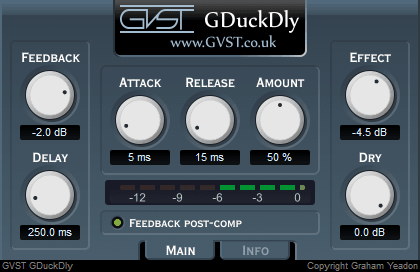GDuckDly Manual
Welcome to GDuckDly
GDuckDly is a digital delay that allows the wet signal to be compressed by the dry signal. This means that the delayed signal is attenuated whenever the input signal is loud enough. As a result, the delayed signal "ducks" under any incoming sounds, preventing the resulting signal from becoming overwhelmed by delay-line "mud".
Installation
- All GVST plug-ins come compressed in a ZIP file, so the first step is to extract the files from the ZIP file.
- Once extracted, you should have one or more DLL files, these are the plug-in files.
- You need to copy the plug-in files to the appropriate folder for your host program.
- In most cases, you will need either to restart the host program or re-scan the plug-in folder in order for newly-installed plug-ins to appear.
Hints
- GDuckDly can be used to add a heavy delay effect to a vocal track without making it unintelligible. You will need to use a fast attack setting for the compressor.
- For vocals, it is often desirable to set the feedback to "post-compressor". This causes only the most recent noise to be repeated.
Interface

The GUI features seven knobs and a switch that control all of GDuckDly's parameters. There is also a gain reduction meter.
Delay: This controls the amount of time between the input and the first repetition.
Feedback: If the output is fed back into the delay line, then the signal will be repeated again and again, until it becomes too quiet to be heard. This control sets how much of the output signal is fed back. If this is set to 0dB then the signal will never become too quiet and will be repeated indefinitely.
Feedback Post-Compressor: To use the ducking analogy, when feedback is set to pre-compressor, any delayed sound ducks under incoming sounds and then stands back up. When feedback is set to post-compressor, delayed sounds duck and stay down.
Attack, Release and Amount: These parameters control the compression. "Attack" and "Release" set the speed at which the volume of the delayed signal is reduced and subsequently restored. The "Amount" parameter determines how much the volume is reduced.
Dry and Effect: These parameters control the output levels of the original and the delayed signals.
License
- GVST plug-ins are provided to the user at no cost. While every GVST plug-in is tested to the best of the developer's ability, no warranty or guarantee is offered to the end user.
- No suggestions made by the developer or his representatives (i.e., freely offered support) are to be taken as an implied warranty or guarantee.
- These plug-ins may only be distributed by the official GVST website, or by parties explicitly given permission by the developer.
- GVST plug-ins are to be distributed only in their original form as intended by the developer (i.e., the unaltered archive).
- GVST plug-ins are freeware, meaning you are never under any obligation to pay for them! However, should you wish to help support continued development of GVST software, please consider donating through the official website.
Credits
- Development, code, website and graphics by Graham Yeadon.
- Documentation by Greg Pettit and Graham Yeadon (many thanks to Greg for all of his help).
- VST technology copyright Steinberg GmbH.
- The "VST" name and logo are registered trademarks of Steinberg GmbH.
- "Windows" is a registered trademark of Microsoft Corporation.
- "Mac" and "OSX" are trademarks of Apple Inc.
